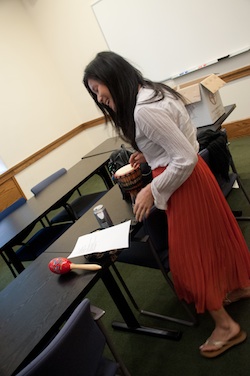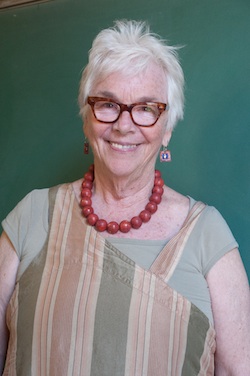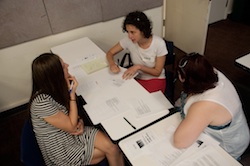Filed Under > TC Community
Poetry in Motion
A TC student's firsthand account of applying lecturer Pat Zumhagen's methods for using drama and other art forms to interpret written text.
In today’s test-oriented education climate, with its emphasis on education as an engine for driving economic competitiveness, the arts often get a bad rap. Some educators simply dismiss them as having little to do with “real learning,” while others argue that teachers often use music, art and even literature as ways to fill up time in the classroom. And in fact, Pat says, some novice teachers who haven’t been properly coached wind up of doing just that.
But Pat, who developed her ideas under the mentorship of Cecily O’Neill, an internationally recognized leader in drama-based pedagogy, believes that these other art forms are a powerful way to invite students into the text and stimulate their creative imagination so that they will become active thinkers rather than simply passive consumers. When struggling readers engage with literature on a deep level – for example, by creating their own text-based artwork – they can improve their comprehension and come away with an increased sense of ownership.
Not that literature students should just sit around and make nice pictures. Pat believes that to effectively interpret a poem, students must become expert on the original text as well as on contextual information such as the history and social mores of a given time period.
Pat doesn’t let English teachers off easily, either. By getting them to use other art forms in the classroom, she challenges them to think of different ways to present the material. Pat’s method also calls for teachers to lead follow-up class discussions or assign written essays about the creative process.
Each summer, Pat brings students in TC’s Intensive Summer Teaching of English Program (INSTEP) to the Lincoln Center Education Center, where they spend a week working with one piece of art – painting, musical, dramatic performance – applying the aesthetic education principles of TC professor emerita Maxine Greene.
The students follow a three-step process involved, first deeply observing their chosen piece of art, then analyzing its unique qualities and finally offering an interpretive claim about it.
At that point, back at TC, Pat steps in to lead the students in adapting this same methodology to literature, with a particular eye toward applying their interpretive experiences to classroom teaching.
At her workshop, Pat asked everybody in attendance to read Pablo Neruda’s “With Clenched Soul” and then break into groups to create original works of art based on the poem.
One group created a dramatic scene that captured the poem’s memories of a lost love, embedding lines from the text into the dialogue. Silence descended on the room, as the actors finished their scene by lying on the stage and reciting the final three words -- “twilight erasing statues.”
Another group created an arrangement of djembe drums, harmonized vocals, and maracas to accompany a two-speaker recitation of the poem. The group improvised the lighting, using a smart board projector in the classroom to flood the stage and their bodies in a deep blue, adding to the poem’s closing mood of despair.
“As we were writing our song, we noticed the possibility of there being two speakers in the poem, which creates an entirely different interpretation,” said one student. “I didn’t see that possibility before. Writing a song and working in the group really opened the poem’s meaning.”
Still another group created a drawing that depicted, in linear fashion, the poem’s theme of change. The colors in the drawing ranged from warm to cool, mirroring the transition in the poem from day to night and from happiness to despair.
Of course, the arts can be a teaching tool for more than just literature. For example, Social Studies teachers can use Pat’s approach to help students investigate culture and history. “So much of art is influenced by other media,” Pat says. She hopes to create an interdisciplinary course that brings all the resources of TC’s Arts and Humanities Department to bear on the process of translating a piece of prose into other art forms.
For me, the experience of creating art to interpret poetry really confirmed that reading is an active process of engaging the text. I will certainly use this method with my future students. The lessons don’t end there, however. After participating in the workshop, I now know that one can even smile and have fun with a clenched soul.
Steven Kroll is a master’s degree student in English Education at Teachers College
Published Thursday, Jul. 19, 2012


